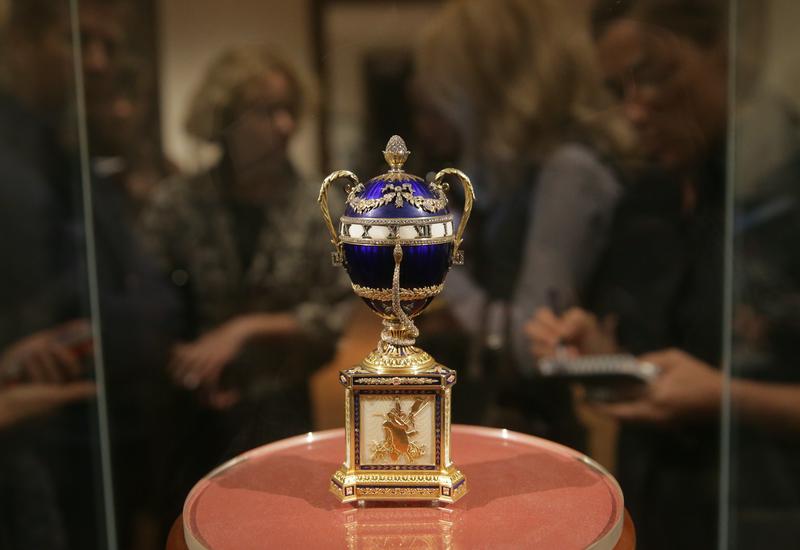The Story of Fabergé’s Fabulous Eggs
By | June 29, 2019

On Easter Day in 1885, the Russian Czar, Alexander III of House Romanov, gave to his wife, Czarina Marie Fedorovna an egg. It looked like a ducks egg, with a gold band about the middle. But when she opened it, she found to her delight a perfect golden yolk, and within that, a golden hen sitting on a golden nest. Inside the hen, was a diamond miniature of the imperial crown, which hid a small ruby pendant.
This egg, known as the First Hen Egg, or the Jewelled Hen Egg, was the first in a line of Carl Fabergé’s Imperial Eggs that have awed the world for their beauty, detail, and cleverness.

Peter Carl Fabergé (1846-1920)
Carl Fabergé’s ancestors were French protestants who left France in 1685 when Louis XIV repealed the Edict of Nantes which had guaranteed religious toleration. The family migrated east, eventually settling in the Russian Empire. They took on various, similar names: Favry, Fabri, Fabrier and finally Fabergé. The name derives from the Latin word “faber” meaning “maker.” This was propitious since at least Carl Fabergé’s father, Gustav, was a master goldsmith and Carl was destined to become one of the most noted jewelers in history. The name change to Fabergé may have been an attempt by the family to ingratiate itself with the Russian aristocracy, which spoke French and looked at France as the source of high culture. In any case, Fabergé set up shop in St. Petersburg in 1842 under the name House of Fabergé. Carl took over the business after training abroad with jewelers in England, Italy, Paris, and Frankfurt. He had developed a vision, beyond just the assemblage of lots of “bling” and valued art and statement. He said later in life, “Expensive things interest me little if the value is merely in so many diamonds or pearls.”

Breakthrough
The breakthrough for House Fabergé was in 1882 when after an exhibition of their work in Moscow when the jewelry firm was noticed by the imperial family.
Czar Alexander III had given jeweled Easter eggs to the Czarina on previous occasions and had commissioned a new one through his brother, Grand Duke Vladamir, with House Fabergé in 1885 for 4,151 rubles. It was not a tremendous sum for the Czar whose income was about 9 million rubles annually. This Hen Egg, as described before, was a tremendous success. Six weeks following the delivery of the Hen Egg, the imperial court decreed that House Fabergé would “bear the title Supplier to the Imperial Court with the right to bear the State Coat of Arms in his shop’s sign.”

An Imperial Family Tradition
After Alexander III died in 1894, his son Nicholas II began presenting Fabergé eggs to his wife Alexandra Fedorovna as well as his mother Marie. Every year, House Fabergé crafted new eggs for the Romanovs with the exception of the years 1904 and 1905 due to the Russo-Japanese War.

Each Egg is Unique
Each Fabergé egg was unique. The egg itself was made of various, fine materials and inside there was always a surprise. For example, the 1906 “Swan Egg” had inside miniature mechanical swan that sat on “pond” of aquamarine. The 1900 Cuckoo Clock Egg and the 1911 Bay Tree Egg featured singing birds that poked out of the top. The 1900 Egg featured a miniature mechanical train, to celebrate the completion of the Trans-Siberian Railway.

The Imperial Coronation Egg
Perhaps the most iconic of the Fabergé eggs was the Imperial Coronation Egg of 1897 which was given to Alexandra to commemorate her ascendency to Czarina the prior year. Inside the gold egg is an exact replica of the coach that transported her to the coronation ceremony. The Fabergé eggs awed the world, and other, private individuals commissioned House Fabergé to make them their own eggs. It is generally acknowledged that while these eggs are beautiful, they are either copies of or of less quality than the Imperial eggs.

Crafting an Egg
Each egg took about a year to make, and it was crafted under the greatest secrecy. Carl Fabergé generally did not directly craft the egg, but rather his team of artisans in various workshops would spend the year planning and executing the various elements of an Egg.

Scrambled Eggs
The last Imperial egg, the Karelian Birch Egg was produced in 1917. After that, the Russian Revolution swept away the Czars. House Fabergé was nationalized in 1918 and the family left Russia after that. Meanwhile, the eggs were scattered with many being confiscated by the state and eventually either being put on display in museums or finding their way into the hands of private collectors. Of the 65 Imperial eggs, 57 have survived. In some instances the surprise inside is all that is left, in others, the surprise is missing. The largest collection of Fabergé eggs, ten of them, is at the Kremlin Armoury. The next largest collection of nine eggs was assembled by Malcolm Forbes. This collection was bought in 2004 by the Russian billionaire Victor Vekselberg for over $100 million. Vekselberg built a museum in St. Petersburg to feature these nine Imperial eggs as well as other, non-Imperial eggs which opened in 2014.

Lost and Found
It is fortunate that so many Imperial Eggs have survived the tumult of the 20th century. And even on occasion, the missing ones show up. The same year that the Fabergé Museum opened in St. Petersburg, the Third Imperial Egg which featured a clock turned up at Midwestern flea market in the early 2000s where a scrap dealer bought it for $13,302. In 2012 he discovered through a google search, that the egg which had been sitting in his kitchen might be an authentic Fabergé egg. He connected with experts and the discovery became one of the most amazing stories in art history.

